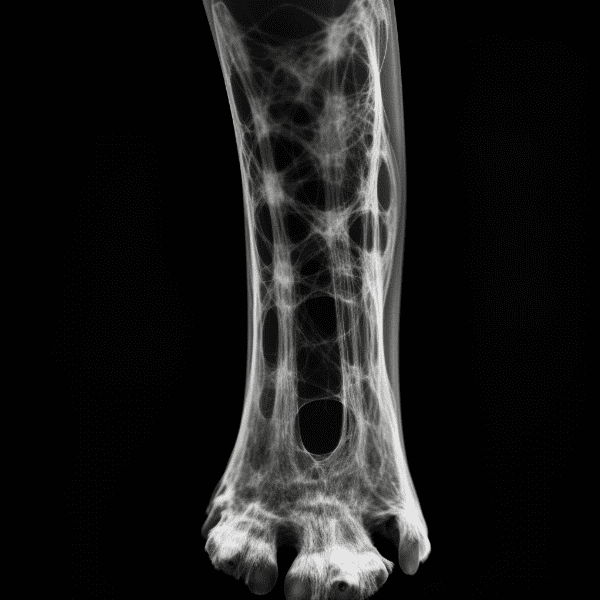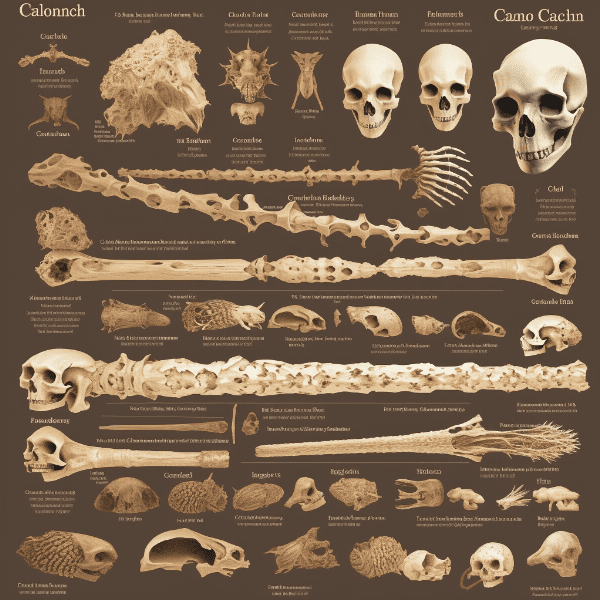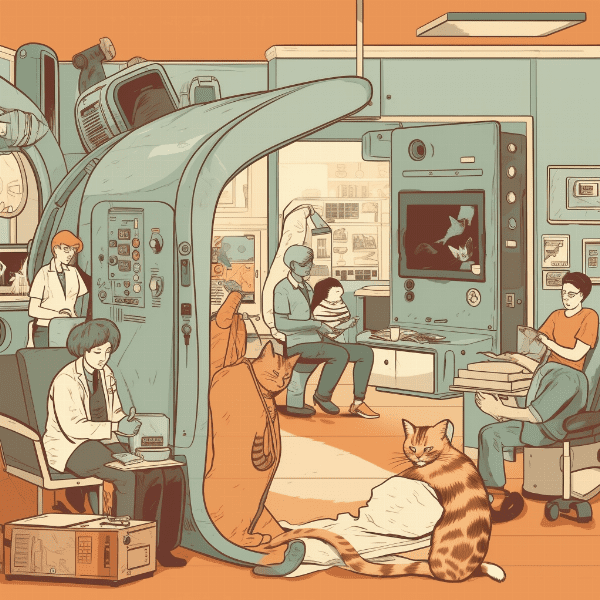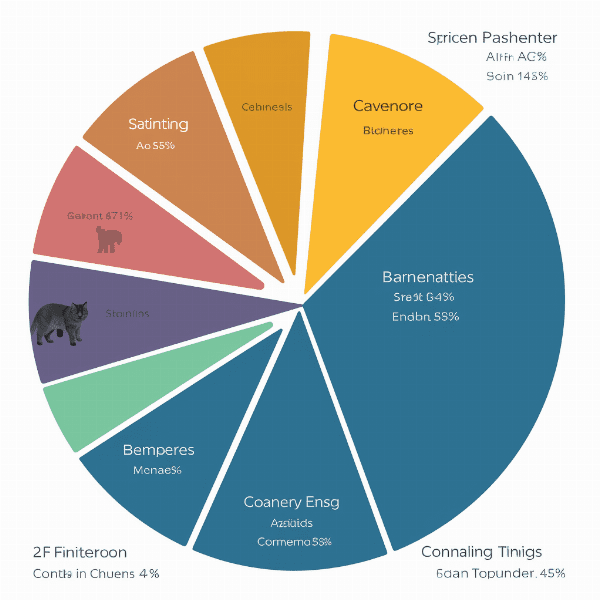Table of Contents
- What is Feline Bone Cancer?
- Types of Feline Bone Cancer
- Symptoms of Feline Bone Cancer
- Diagnosis of Feline Bone Cancer
- Staging of Feline Bone Cancer
- Treatment Options for Feline Bone Cancer
- Post-Treatment Care for Cats with Bone Cancer
- Prognosis and Survival Rates for Feline Bone Cancer
- Palliative Care for Cats with Advanced Bone Cancer
- Preventing Feline Bone Cancer: Tips and Recommendations.
What is Feline Bone Cancer?
Feline bone cancer, also known as osteosarcoma, is a type of cancer that originates in the bones of cats. It is an aggressive cancer that commonly affects the long bones of the legs, but can also occur in other bones such as the jaw, ribs, and spine.
Causes of Feline Bone Cancer
The exact causes of feline bone cancer are not fully understood. However, certain factors may increase a cat’s risk of developing this condition. For example, older cats and those with a history of bone injuries or fractures are more prone to developing bone cancer. Additionally, certain breeds such as Siamese and Abyssinian cats may have a higher predisposition to this type of cancer.
Spread of Feline Bone Cancer
Feline bone cancer can spread to other parts of the body, including the lungs, lymph nodes, and other bones. When the cancer spreads, it is known as metastasis, and this can significantly reduce a cat’s chances of survival.
Symptoms of Feline Bone Cancer
Feline bone cancer can be difficult to detect in the early stages. However, as the cancer progresses, cats may experience pain, lameness, and swelling in the affected area. Other symptoms may include decreased appetite, lethargy, and weight loss.
Importance of Early Detection
Early detection is critical for the successful treatment of feline bone cancer. Therefore, it is important for cat owners to be vigilant and seek veterinary care as soon as they notice any unusual symptoms or changes in their cat’s behavior.

Types of Feline Bone Cancer
There are several different types of bone cancer that can affect cats. The most common type of Bone cancer in cats is osteosarcoma, which accounts for approximately 80% of all bone tumors in felines. However, there are other types of bone cancer that can occur in cats as well.
Osteosarcoma
Osteosarcoma is a malignant tumor that originates in the bone cells of cats. It is most commonly found in the long bones of the legs, but can also occur in other bones such as the jaw, ribs, and spine. Osteosarcoma is an aggressive cancer that can spread quickly and significantly reduce a cat’s quality of life.
Chondrosarcoma
Chondrosarcoma is a type of bone cancer that originates in the cartilage cells of cats. It is a less aggressive form of cancer than osteosarcoma, but can still cause significant discomfort and pain for affected cats. Chondrosarcoma is commonly found in the bones of the nasal cavity, but can also occur in other areas of the body.
Fibrosarcoma
Fibrosarcoma is a rare type of bone cancer that originates in the fibrous connective tissues of cats. It can occur in any bone of the body, but is most commonly found in the bones of the head and jaw. Fibrosarcoma is an aggressive form of cancer that can spread quickly and affect other areas of the body.
Multilobular Osteochondrosarcoma
Multilobular osteochondrosarcoma is a type of bone cancer that affects the skull bones of cats. It is a rare form of cancer that originates in the cells that form the connective tissue of the skull. Multilobular osteochondrosarcoma can cause significant deformities in the cat’s head, and can also spread to other areas of the body.
In the next section, we will discuss the common symptoms of feline bone cancer that cat owners should be aware of.

Symptoms of Feline Bone Cancer
The symptoms of feline bone cancer can vary depending on the type and location of the tumor. In the early stages, cats may not show any noticeable symptoms. However, as the cancer progresses, cats may exhibit a range of symptoms that can indicate the presence of bone cancer.
Pain and Discomfort
One of the most common symptoms of feline bone cancer is pain and discomfort. Cats with bone cancer may experience lameness or limping, and may avoid putting weight on the affected limb. They may also show signs of pain when the affected area is touched or manipulated.
Swelling and Lumps
Feline bone cancer can cause swelling and lumps in the affected area. This is caused by the growth of the tumor, which can put pressure on surrounding tissues and cause them to swell. In some cases, the tumor may be visible as a lump under the skin.
Reduced Mobility
Cats with bone cancer may experience a reduced range of motion in the affected area. This can make it difficult for them to perform certain activities such as jumping, climbing, or grooming themselves.
Decreased Appetite and Weight Loss
Feline bone cancer can cause cats to lose their appetite and experience weight loss. This is often a sign that the cancer has spread to other parts of the body, and can significantly reduce a cat’s quality of life.
Other Symptoms
In some cases, cats with bone cancer may exhibit other symptoms such as lethargy, fever, or vomiting. These symptoms can indicate that the cancer has spread to other parts of the body and requires immediate veterinary attention.
If you notice any of these symptoms in your cat, it is important to seek veterinary care as soon as possible. In the next section, we will discuss the diagnostic process for feline bone cancer.

Diagnosis of Feline Bone Cancer
The diagnosis of feline bone cancer typically involves a combination of physical examination, imaging tests, and biopsy. These tests are used to confirm the presence of bone cancer and determine the type and stage of the cancer.
Physical Examination
The first step in diagnosing feline bone cancer is a physical examination. During the examination, the veterinarian will look for signs of pain, swelling, or lumps in the affected area. They may also manipulate the limb or joint to check for range of motion and signs of discomfort.
Imaging Tests
Imaging tests such as X-rays, CT scans, and MRI scans can help to identify the location and extent of the bone cancer. These tests can also be used to determine if the cancer has spread to other parts of the body.
Biopsy
A biopsy involves taking a sample of the affected tissue and examining it under a microscope to determine if it is cancerous. Biopsies can be performed using a needle or by surgically removing a small portion of the affected bone.
Staging
Once a diagnosis of feline bone cancer has been confirmed, the cancer is staged to determine the extent of the cancer and the best treatment options. Staging involves using imaging tests to check for the spread of the cancer to other parts of the body.

Staging of Feline Bone Cancer
Staging is an important step in the diagnosis and treatment of feline bone cancer. It involves using imaging tests to determine the extent of the cancer and the best treatment options for the cat. Staging is typically based on a system known as the TNM staging system.
Tumor Size and Location
The T stage of the TNM system refers to the size and location of the primary tumor. This is determined using imaging tests such as X-rays, CT scans, and MRI scans. Tumor size and location can impact the treatment options and prognosis for the cat.
Lymph Node Involvement
The N stage of the TNM system refers to the involvement of lymph nodes in the cancer. If the cancer has spread to the lymph nodes, it can impact the prognosis and treatment options for the cat.
Metastasis
The M stage of the TNM system refers to the presence of metastasis, or the spread of the cancer to other parts of the body. Metastasis can significantly reduce a cat’s chances of survival, and can impact the treatment options available.
Overall Staging
Once the T, N, and M stages have been determined, the cancer is staged overall using a combination of these factors. The stage of the cancer is an important factor in determining the best treatment options and prognosis for the cat.
By using the TNM staging system, veterinarians can accurately determine the extent of feline bone cancer and develop an effective treatment plan. In the next section, we will discuss the treatment options available for feline bone cancer.

Treatment Options for Feline Bone Cancer
The treatment options for feline bone cancer depend on the type and stage of the cancer, as well as the overall health and age of the cat. Treatment typically involves a combination of surgery, radiation therapy, and chemotherapy.
Surgery
Surgery is often the first line of treatment for feline bone cancer. The goal of surgery is to remove the tumor and any surrounding tissue that may be affected by the cancer. Depending on the location and size of the tumor, the affected limb or joint may need to be amputated.
Radiation Therapy
Radiation therapy involves using high-energy radiation to kill cancer cells. This treatment is often used after surgery to kill any remaining cancer cells and prevent the cancer from returning. Radiation therapy can also be used as a palliative treatment to relieve pain and discomfort in cats with advanced bone cancer.
Chemotherapy
Chemotherapy involves using drugs to kill cancer cells throughout the body. This treatment is often used in conjunction with surgery and radiation therapy to improve the overall effectiveness of the treatment. Chemotherapy can also be used as a palliative treatment to relieve pain and discomfort in cats with advanced bone cancer.
Palliative Care
The specific treatment options for feline bone cancer will depend on the type and stage of the cancer, as well as the overall health and age of the cat. It is important to work closely with your veterinarian to develop an individualized treatment plan for your cat.

Post-Treatment Care for Cats with Bone Cancer
After treatment for feline bone cancer, it is important to provide your cat with proper post-treatment care. This can help to improve their chances of recovery and minimize the risk of complications.
Wound Care
If your cat underwent surgery to remove the tumor, it is important to keep the surgical site clean and dry. Your veterinarian may recommend a special wound dressing or bandage to protect the area and promote healing. It is important to follow your veterinarian’s instructions for wound care to prevent infection and other complications.
Medications
Your cat may need to take medications such as pain relievers or antibiotics after treatment for bone cancer. It is important to give your cat these medications as prescribed by your veterinarian to ensure that they are effective and minimize the risk of side effects.
Follow-up Care
Regular follow-up appointments with your veterinarian are important after treatment for bone cancer. These appointments can help to monitor your cat’s recovery and detect any potential complications or recurrence of the cancer.
Providing proper post-treatment care for your cat can help to improve their chances of recovery and minimize the risk of complications. It is important to work closely with your veterinarian to develop an individualized post-treatment care plan for your cat.

Prognosis and Survival Rates for Feline Bone Cancer
The prognosis and survival rates for feline bone cancer depend on several factors, including the type and stage of the cancer, the age and overall health of the cat, and the treatment options used.
Prognosis
The prognosis for feline bone cancer can vary widely depending on the type and stage of the cancer. Osteosarcoma, the most common type of bone cancer in cats, has a poor prognosis, with an average survival time of 4-6 months without treatment. However, with aggressive treatment such as surgery, radiation therapy, and chemotherapy, the prognosis can be significantly improved.
Survival Rates
The survival rates for feline bone cancer depend on several factors, including the stage of the cancer and the treatment options used. In general, cats with localized bone cancer (i.e., cancer that has not spread to other parts of the body) have a better chance of survival than those with metastatic cancer. The survival rates for cats with bone cancer can range from several months to several years, depending on the individual case.
Quality of Life
In addition to prognosis and survival rates, it is important to consider the cat’s quality of life when making treatment decisions for feline bone cancer. Treatment options such as amputation or aggressive chemotherapy may significantly impact the cat’s quality of life, and should be carefully considered in conjunction with the potential benefits.
Ultimately, the prognosis and survival rates for feline bone cancer depend on a variety of factors, and it is important to work closely with your veterinarian to develop an individualized treatment plan that takes into account your cat’s specific needs and circumstances.

Palliative Care for Cats with Advanced Bone Cancer
In cases where feline bone cancer has progressed significantly or where the cat is not a good candidate for aggressive treatment, palliative care may be recommended. Palliative care focuses on providing the cat with relief from pain and discomfort, and improving their quality of life.
Pain Management
One of the most important aspects of palliative care for cats with advanced bone cancer is pain management. This may involve the use of pain relievers such as nonsteroidal anti-inflammatory drugs (NSAIDs) or opioids, as well as other pain management techniques such as acupuncture or massage therapy.
Nutritional Support
Cats with advanced bone cancer may experience a loss of appetite or difficulty eating due to pain or discomfort. Nutritional support such as the use of appetite stimulants or feeding tubes may be recommended to ensure that the cat receives proper nutrition.
Environmental Modifications
Environmental modifications can help to improve the cat’s comfort and quality of life. This may include providing soft bedding, modifying the cat’s living space to make it easier for them to move around, and providing a litter box with low sides.
Emotional Support
Caring for a cat with advanced bone cancer can be emotionally challenging for both the cat and the owner. Emotional support such as counseling or support groups may be recommended to help cope with the stress and anxiety of caring for a sick cat.
Palliative care can help to improve the quality of life for cats with advanced bone cancer, and provide them with comfort and support during their final days. It is important to work closely with your veterinarian to develop an individualized palliative care plan for your cat.

Preventing Feline Bone Cancer: Tips and Recommendations.
While there is no surefire way to prevent feline bone cancer, there are some steps that can be taken to reduce the risk of developing the disease.
Diet and Nutrition
Proper nutrition can play an important role in preventing feline bone cancer. Feeding your cat a well-balanced diet that is high in protein and low in carbohydrates can help to support their overall health and reduce the risk of cancer. Additionally, providing your cat with fresh water and avoiding exposure to contaminated water sources can help to reduce the risk of bone cancer.
Exercise and Activity
Regular exercise and activity can help to keep your cat’s bones and joints healthy, reducing the risk of bone cancer. Providing your cat with toys and activities that encourage movement and play can help to keep them active and engaged.
Environmental Factors
Exposure to certain environmental factors can increase the risk of feline bone cancer. Limiting your cat’s exposure to environmental toxins such as cigarette smoke, pesticides, and other chemicals can help to reduce the risk of bone cancer.
Early Detection
Regular veterinary check-ups and screening tests can help to detect feline bone cancer early, when it is most treatable. It is important to work closely with your veterinarian to develop a screening plan that is appropriate for your cat’s age and health status.
While there is no guaranteed way to prevent feline bone cancer, taking steps to support your cat’s overall health and wellbeing can help to reduce their risk of developing the disease. It is important to work closely with your veterinarian to develop a preventative care plan that is appropriate for your cat.




